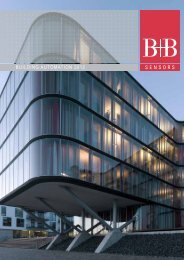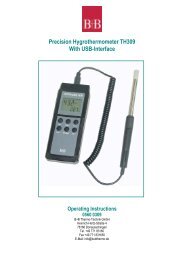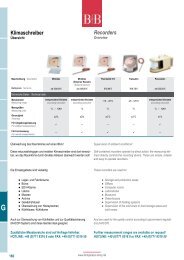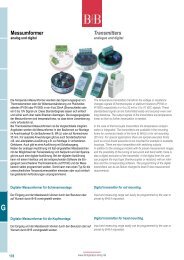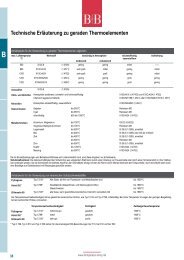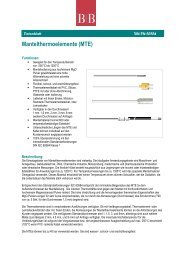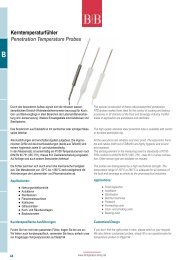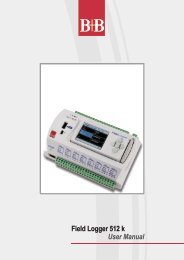B - Temperatur-Shop
B - Temperatur-Shop
B - Temperatur-Shop
You also want an ePaper? Increase the reach of your titles
YUMPU automatically turns print PDFs into web optimized ePapers that Google loves.
Technical terms for the temperature and humidity measurement<br />
This glossary describes the most important technical terms for the temperature measurement<br />
°C (Centigrade)<br />
Based on the fix points 0 °C as freezing point of water and 100 °C as vaporisation point<br />
of water at standard pressure.°C = (°F - 32) / 1,8<br />
°F (Fahrenheit)<br />
<strong>Temperatur</strong>e scale °F =°C x 1,8 + 32 = °R – 459,67<br />
°R (Rankine)<br />
<strong>Temperatur</strong>e scale °R = °F + 459,67<br />
%RH<br />
The relative humidity is the relationship of water vapour partial pressure in the test gas to<br />
maximum possible water vapour partial pressure (water vapour-saturation pressure) at<br />
the same temperature and total pressure<br />
A<br />
Absolute humidity<br />
The absolute humidity is the mass of water vapour per unit volume of humid gas.<br />
Absolute zero<br />
The temperature of -273.15 °C, -459.69 °F, or 0 K; thought to be the temperature at<br />
which molecular motion vanishes and a body would have no heat energy.<br />
Accuracy<br />
The maximum deviation in a set of measurements between the temperature indicated by<br />
a radiation thermometer and the known temperature of a reference source, including the<br />
uncertainty of the reference temperature source. The accuracy can be expressed in a<br />
variety of ways including temperature, percentage of temperature reading, or percentage<br />
of full scale temperature of an instrument.<br />
Ambient derating<br />
Derating or decrease in accuracy of an instrument due to changes in its ambient temp<br />
from that at which it was calibrated. See also temperature coefficient.<br />
Ambient operating range<br />
Range in the ambient temperature over which the instrument is designed to operate.<br />
Ambient temperature<br />
The temperature of the instrument. Can also refer to the temperature that gives rise to<br />
the background. See Background Radiation.<br />
Ambient temperature compensation (TAMB)<br />
See Reflected Energy Compensation.<br />
ASTM<br />
American Society for Testing and Materials.<br />
ASTM E 1256<br />
ASTM E1256 - 88, Standard Test Methods for Radiation Thermometers (Single Waveband<br />
type). A standard by which Raytek products are tested and calibrated for accuracy,<br />
repeatability, resolution, target size, response time, warm-up time, and long-term drift.<br />
Atmospheric windows<br />
The spectral bands in which the atmosphere least affects the transmission of radiant<br />
energy. The spectral bands are 0.4 to 1.8, 2 to 2.5, 3 to 5, and 8 to 14 micrometers.<br />
B<br />
Background radiation<br />
Radiation that enters an instrument from sources other than the intended target.<br />
Background radiation can enter due to reflections from the target or scattering within the<br />
instrument.<br />
Blackbody<br />
An ideal thermal radiator that absorbs all of the radiation incident thereon, and the radiant<br />
emission from which is quantified by Planckís Radiation Law.<br />
C<br />
Calibration procedure<br />
A procedure that is performed to determine and set the parameters affecting an instrument’s<br />
performance in order to ensure its designed function within prescribed limits.<br />
Calibration source<br />
Carnot cycle<br />
An ideal heat engine that converts thermal energy to mechanical work with the greatest<br />
efficiency that can be achieved.<br />
Celsius or C<br />
The temperature scale in which the temperature in Celsius (TC) is related to the temperature<br />
in Kelvin (TK) by the formula; TC = TK -273.15. The freezing point of water at<br />
standard atmospheric pressure is very nearly 0 °C, and the corresponding boiling point is<br />
very nearly 100 °C. Formerly known as centigrade temperature scale.<br />
Color temperature<br />
The temperature of a black body from which the radiant energy has the same spectral<br />
distribution as that from a surface.<br />
Colored body or non gray body<br />
A source of thermal emission for which the emissivity depends on wavelength and is not<br />
constant.<br />
Comparison pyrometry<br />
Method of radiation thermometry wherein the temperature of a calibrated source is<br />
changed until the radiation received from the source is the same as that from the target<br />
to determine the temperature of the target.<br />
Current-loop<br />
A form of communications wherein a pair of wires is used to transmit the signal as a<br />
current. Levels of 4 to 20 mA are often used to indicate the minimum and maximum<br />
signal level, respectively. Sometimes, for digital applications, various magnitudes of mA<br />
current are used to indicate a logical 1 and 0. The current loop is often characterized by<br />
a maximum impedance of the device that is connected to the loop.<br />
D<br />
D:S<br />
Optical resolution expressed as a ratio of the distance to the resolution spot divided by<br />
the diameter of the spot.<br />
Deadband<br />
<strong>Temperatur</strong>e band (±) about the set point, wherein an alarm output or relay can not<br />
change state, thus providing hysteresis.<br />
www.temperatur-shop.de 213



